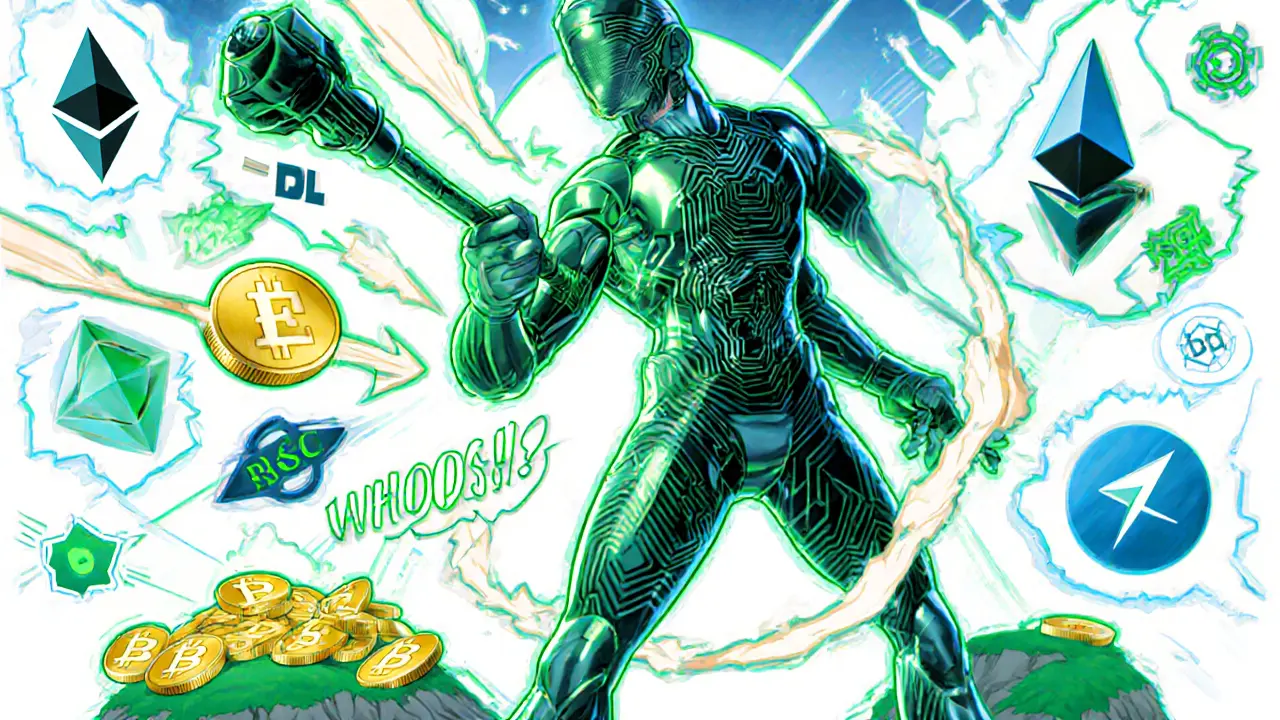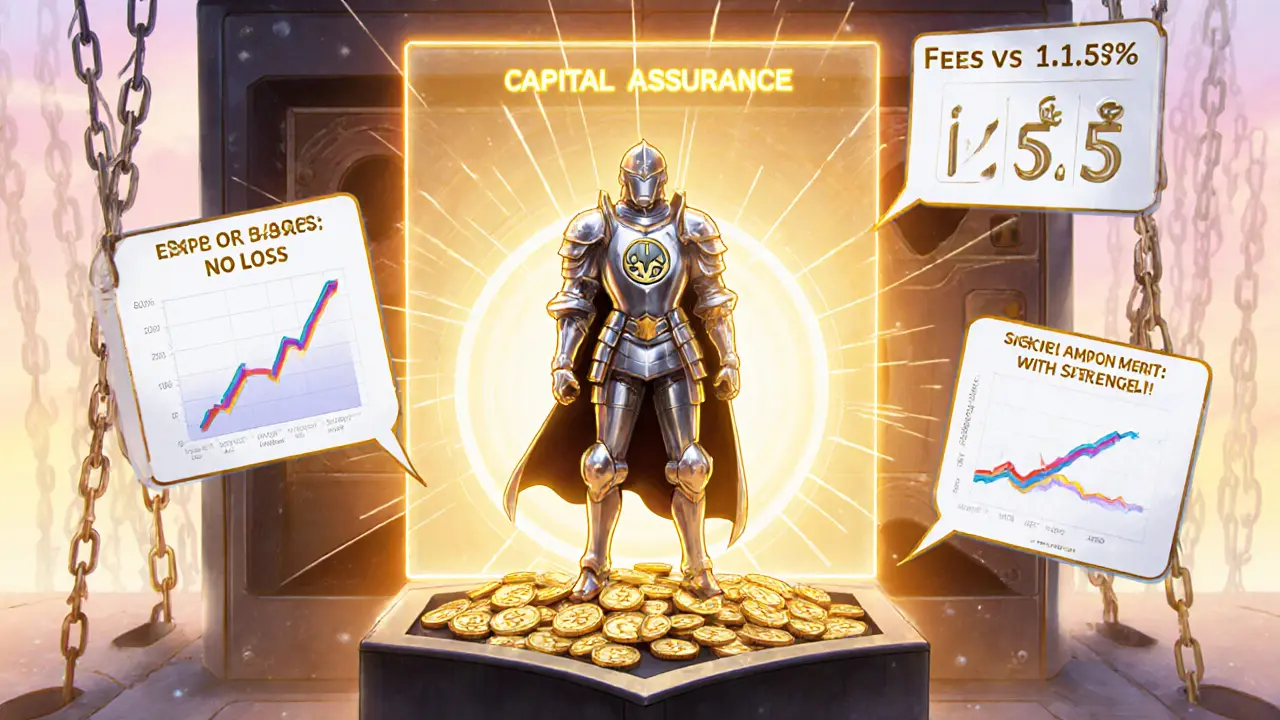Elk Finance Cross-Chain Swap Calculator
Swap Results
Cross-Chain Swap
Elk Finance supports 14 chains with optimized routing
Fee Reduction
Staking ELK reduces fees from 0.25% to 0.15%
Capital Assurance
Liquidity protection guarantees no loss
Key Takeaways
- Elk Finance is a DeFi platform built for cross‑chain swaps, not to be confused with Elastos.
- The native ELK token is used for governance, fee rebates and liquidity incentives.
- Liquidity providers are protected by a capital‑preservation mechanism that guarantees at least the initial deposit.
- Trading fees are typically under 0.25% and can be reduced further with ELK staking.
- Compared with rivals like Thorchain and Curve, Elk offers deeper pools on 14 chains but lower overall TVL.
When people talk about Elk Finance is a decentralized finance (DeFi) platform that focuses on cross‑chain liquidity aggregation, they’re usually looking at a solution that tries to make token swaps across dozens of blockchains cheap and fast. The project launched its native ELK token in early 2023 and quickly added a proprietary stablecoin to boost pool depth. Below is the full breakdown you need before putting any money on the platform.
What is Elk Finance?
Elk Finance positions itself as a “one‑stop shop” for cross‑chain swapping. Unlike traditional DEXs that operate on a single chain, Elk runs a set of smart contracts on each supported network and links them through a proprietary routing engine. The engine finds the cheapest path across all available pools, splitting a single swap into multiple hops if needed. This architecture lets users move assets between, for example, Ethereum, Binance Smart Chain, Solana, and 11 other blockchains at once.
Core Features and Tokenomics
The ecosystem rests on three pillars:
- ELK token - used for governance votes, fee rebates (up to 50% off for stakers), and as a reward for liquidity providers.
- Proprietary stablecoin - pegged to USD, it pads liquidity pools so that even low‑volume pairs retain reasonable depth.
- Cross‑chain liquidity vaults - each vault holds a basket of assets on a specific network, and the routing layer dynamically routes orders through these vaults.
The total supply of ELK is capped at 100million, with 30million allocated to the community vault, 25million for ecosystem development, 20million for the team (vested over four years), and the remaining 25million slated for liquidity mining.
Cross‑Chain Liquidity Mechanism
Elk Finance’s routing algorithm works like this:
- User initiates a swap on any supported chain.
- The smart‑contract router queries all available pools across the 14 networks.
- It calculates the optimal path, combining on‑chain swaps and inter‑chain bridges.
- The router executes the series of swaps atomically, meaning either the whole sequence succeeds or it reverts.
This design eliminates the need for users to manually bridge tokens, cutting down on both time and fees. Because each pool is backed by the stablecoin, slippage stays under 0.5% even for trades that cross multiple chains.
Security and Liquidity Provider Protection
Security is a top concern for any DeFi protocol. Elk Finance audits its contracts annually through a top‑tier firm (the latest report from Q32024 confirmed no critical vulnerabilities). In addition, the platform introduces a “Capital Assurance” module: when a liquidity provider (LP) adds assets, the protocol records the deposit amount on‑chain and guarantees that withdrawals will never be less than that baseline, regardless of market volatility. This is enforced by a smart‑contract escrow that locks a portion of the ELK token supply as a buffer.

User Experience: Interface, Wallet Integration, Fees
From a user’s perspective, Elk Finance feels like a hybrid between a DEX aggregator and a centralized exchange dashboard. The web UI shows a single “Swap” box, a list of supported chains, and real‑time price quotes. For wallets, Elk Finance integrates natively with MetaMask, Trust Wallet, and the built‑in Elk Wallet mobile app (iOS & Android). Fees are split into a 0.30% protocol fee and a 0.10% network fee; ELK stakers earn a share of the protocol fee, effectively turning fees into a yield source.
Market Performance and Trading Pairs
As of 1Oct2025, ELK trades on several major DEXs and CEXs, most notably on HTX and Binance. The 7‑day price change sits at +3.30%, outpacing the broader crypto market which posted a -1.2% shift. The top five trading pairs on the Elk platform are:
- ELK/USDT
- ELK/ETH
- ELK/BTC
- ELK/USDC (stablecoin)
- ELK/SOL
Total value locked (TVL) across all chains is roughly $320million, representing about 0.8% of the DeFi market but showing steady growth of 12% month‑over‑month since the stablecoin launch.
How Does Elk Finance Compare to Other Cross‑Chain DEXs?
| Feature | Elk Finance | Thorchain | Curve Finance |
|---|---|---|---|
| Supported Chains | 14 (incl. Ethereum, BSC, Solana, Polygon) | 5 (BTC, BNB, ETH, LTC, AVAX) | 3 (Ethereum, Polygon, Arbitrum) |
| Native Token | ELK (governance, fee rebate) | RUNE (security, liquidity) | CRV (governance, boost) |
| Liquidity Protection | Capital Assurance (no‑loss guarantee) | None (exposed to impermanent loss) | Pool‑specific loss mitigation |
| Average Swap Fee | 0.25% (reducible to 0.15% with ELK) | 0.30% (fixed) | 0.04% (stable‑pair only) |
| TVL (Oct2025) | $320M | $2.1B | $3.5B (mostly stablecoins) |
Elk Finance shines when you need a single‑click bridge between many chains, especially for newer assets on Solana or Polygon. Thorchain offers deeper liquidity but fewer networks, while Curve remains the go‑to for low‑fee stablecoin swaps.
Risks and Limitations
Even with its safeguards, Elk Finance is not risk‑free. The main concerns are:
- Smart‑contract risk: a bug in the routing layer could lock funds across multiple chains.
- Stablecoin peg: the proprietary stablecoin relies on collateral reserves; a sudden market crash could pressure the peg.
- Adoption hurdle: users still need to trust a relatively new platform when alternatives like Thorchain have larger ecosystems.
- Regulatory landscape: cross‑chain bridges are attracting regulator attention; future rules could limit certain functionalities.
Who Should Consider Using Elk Finance?
If you fit one of these profiles, Elk Finance might be worth a look:
- DeFi traders who frequently move assets between Ethereum, BSC, and Solana.
- Liquidity providers seeking capital‑preservation guarantees.
- Investors holding ELK who want to earn protocol‑fee rebates.
- Developers building cross‑chain dApps that need a reliable swap backend.
Casual holders who rarely trade probably won’t benefit much from the platform’s advanced features.
Quick‑Start Checklist
- Install a supported wallet (MetaMask, Trust Wallet, or Elk Wallet).
- Buy a small amount of ELK on a major exchange.
- Stake ELK on the Elk portal to unlock fee discounts.
- Navigate to the “Swap” page, select source and destination chains.
- Confirm the transaction; the router handles the multi‑hop swap automatically.
- Monitor your position in the “Liquidity” tab if you provided assets to a pool.
Following these steps gets you up and running in under five minutes.

Frequently Asked Questions
What is the difference between Elk Finance and Elastos?
Elk Finance (ELK) is a DeFi cross‑chain exchange, while Elastos (ELA) is a blockchain project aiming to build a decentralized internet ecosystem. They have unrelated tokenomics, teams, and use‑cases.
How does Elk Finance protect liquidity providers from loss?
Through the Capital Assurance module, the protocol records each LP’s initial deposit and guarantees that withdrawals will never fall below that amount, regardless of market swings.
Which chains are currently supported?
As of October2025, Elk Finance supports Ethereum, Binance Smart Chain, Solana, Polygon, Avalanche, Fantom, Arbitrum, Optimism, Cosmos, NEAR, Terra, Klaytn, Celo, and Hedera.
Do I need to hold ELK to trade?
No. Anyone can swap tokens without ELK, but holding and staking ELK reduces the protocol fee and grants voting rights.
Is the platform audited?
Yes. The core contracts were audited by CertiK in Q32024, with a follow‑up audit scheduled for early 2026.
How can I earn yield on ELK?
Stake ELK on the Elk portal to receive a share of the protocol fee (currently ~5% APR) and vote on governance proposals.


11 Responses
Looks like Elk Finance is just another front for the big players to siphon off our cross‑chain swaps without us even realizing the hidden fees are baked into the routing algorithm. They claim “capital assurance” but there’s no way a private entity can guarantee zero loss when the bridges themselves are riddled with backdoors. I’m not buying the hype; the whole thing feels like a smoke‑and‑mirrors operation designed to funnel liquidity into proprietary pools that only the insiders can tap. Keep your eyes open and your keys offline.
Wow, this looks super cool!! 😍 I love how easy the swap calculator is, it makes me feel like a crypto wizard 🤓. The UI is really friendly and I can’t wait to try swapping some ELK tokens.
Hope it works smoothly for everyone!!
The fee reduction claim seems overstated given the underlying network costs.
Oh, the drama! Here we are, chasing another “revolutionary” platform while they promise us fee miracles and capital safety. Yet every time you dig deeper, you find the same old story: glossy marketing, hidden complexities, and a thin veil of security that crumbles under scrutiny. It’s like watching the same tired soap opera, where every new character is just a repackaged version of the last, hoping to catch our attention for a fleeting moment. And let’s not forget the inevitable tokenomics trap – you stake, they claim you’ll save a few basis points, but the real profit? It’s the people who built the platform, not the users.
Hey folks, happy to help clarify a few points. Elk Finance indeed supports 14 chains, and the routing engine attempts to find the cheapest path by aggregating liquidity from multiple sources. Staking ELK does lower the fee rate from 0.25 % to 0.15 %, which can add up if you’re moving large amounts regularly. However, remember that the bridge fees on each individual chain still apply, so the total cost may vary. It’s also worth noting that the “capital assurance” refers to a liquidity protection pool that aims to cover slippage losses, but it’s not a guarantee against smart‑contract exploits. Always audit the contracts and consider using a hardware wallet for added safety.
Nice breakdown, thanks! I’ll keep an eye on the pool health and test with a small amount first.
One cannot help but ponder the existential implications of a DeFi platform that touts “assurance” while existing in a realm governed by immutable code; is the assurance a philosophical promise or a technical mirage? The very notion of “cross‑chain” evokes images of bridges that span not only networks but also the epistemic divide between trust and verification. Yet, when the underlying architecture remains opaque, the phrase becomes a linguistic façade, a veneer atop an intricate tapestry of smart‑contract interactions, each woven with its own set of assumptions and vulnerabilities. Consider the cascade effects: a single breach on a source chain could reverberate through the swap, undermining the presumed safety of the destination chain; thus, the promise of “no loss” is, at best, a conditional statement contingent upon an idealized, frictionless ecosystem. In this light, Elk Finance's fee reduction, while numerically appealing, may serve as a distraction from the deeper, systemic risks that pervade the entire DeFi mosaic.
Let us embark on an extensive exploration of the philosophical underpinnings of Elk Finance, a platform that purports to dissolve the boundaries between disparate blockchain ecosystems. First, we must acknowledge that the very concept of "cross‑chain" swaps challenges the conventional siloed architecture of distributed ledgers, proposing instead a fluid continuum where assets traverse unimpeded. Yet, this fluidity is not without friction; each bridge introduces its own set of trust assumptions, governance models, and potential attack vectors. The promise of a 0.15 % fee for staked participants, while numerically attractive, raises questions about incentive structures-does the reduction genuinely reflect a cost saving, or is it a mechanism to induce lock‑up of native tokens, thereby consolidating power? Moreover, the term "capital assurance" suggests a protective layer against loss, but the reality hinges upon the solvency and robustness of the underlying liquidity pool. Should the pool be insufficiently capitalized, the purported safety net collapses, exposing participants to systemic risk.
From a technical perspective, the routing algorithm must evaluate myriad pathways, weighing gas costs, slippage, and bridge reliability. This optimization problem, while sophisticated, cannot account for emergent vulnerabilities that surface post‑deployment. Moreover, the reliance on smart contracts across multiple jurisdictions introduces legal ambiguity-who bears responsibility in the event of a breach?
In broader terms, the platform's narrative fits within a larger discourse on decentralization versus centralization. While Elk Finance markets itself as a decentralized exchange, the necessity of staking and governance mechanisms reintroduces elements of central authority. The tension between user autonomy and platform control manifests in the very design of the fee structure and assurance promises.
Ultimately, the user must weigh the allure of seamless cross‑chain swaps against the intricate tapestry of risk, governance, and economic incentives woven into Elk Finance's architecture. The decision is not merely a financial calculation but an existential choice about one's place in the evolving landscape of decentralized finance.
Great insights, everyone. Remember, it’s always wise to start small, test the waters, and keep your private keys secure. Consistency and caution go a long way in DeFi.
I agree, safety first. Take your time and don’t rush into big swaps until you’re comfortable.
Hey all, let’s keep the vibes friendly and focus on sharing knowledge. I think if we all stay open‑minded and help each otter, we can navigate these platforms together.